Schizophragma - japanese hydrangea vine
 Japanese Hydrangea vine (Schizophragma hydrangeoides) is a lovely ornamental creeper that climbs using aerial rootlets, attaining the height of over 6m and, in its native habitat, even up to 12 m.
Japanese Hydrangea vine (Schizophragma hydrangeoides) is a lovely ornamental creeper that climbs using aerial rootlets, attaining the height of over 6m and, in its native habitat, even up to 12 m.
It belongs to the Hydrangeaceae family and is a close relative to Climbing Hydrangea (Hydrangea anomala subsp. petiolaris). They have similar requirements and the growth habit, but Japanese Hydrangea Vine can boast more attractive flowers than her cousin.
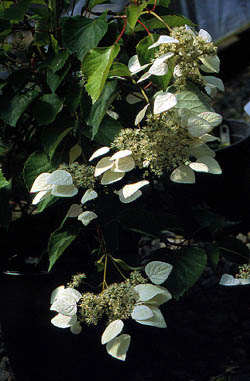 Schizophragma hydrangeoides - flowers - photo Sz. Marczynski |
Small, creamy white honey-scented flowers are borne in densely packed large (25 cm in diameter) flattened cymes from the end of June to the second half of July. Its main attraction are large (3-5 cm), white petals of sterile flowers forming a garland around the flower. Wide-round-oval coarsely toothed leaves are green in summer and yellow in autumn.
Japanese Hydrangea Vine is native to the mountains of Japan, together with Climbing Hydrangea, and can be found climbing up trees or sprawling at their base. Interestingly enough, you can find there the specimens of Schizophragma hydrangeoides that look just like the cultivar 'Moonlight'. During the first two, three years after planting it grows rather slowly, as all the energy of the plant goes into creating the root system. Once it's well settled, and the roots reach groundwater, it starts growing very vigorously producing more than 1 m of new growth a year. It can start blooming in the 2nd-3rd year after planting. It doesn't require pruning, but is tolerant of spring pruning of overgrown shoots.
Apart from the species, there are some attractive cultivars available on the market:
- 'Moonlight' - More vigorous than the species. The leaves have a silvery-grey shading on the upper side. The flowers similar to the species.
- 'Roseum' is another interesting cultivar, though still rarely found on the market. It has pale rose flowers that appear in July. Heart-shaped deep green leaves with a slightly red tinge turn yellow in autumn.
Requirements.
It thrives in humus-rich, light and moist but not waterlogged soil. It isn’t tolerant of drought. It prefers acid soil but will also do well in neutral soil. High air humidity encourages the luxuriant growth. It grows best on a site with a northern aspect or in semi-shade, sheltered from violent winds. Young plants don't like direct sunlight, whereas older plants benefit from having their upper part in full sun and flower more profusely.
Schizophragma hydrangeoides is sufficiently frost-hardy (zones 5-8) and can grow in most parts of Poland. However, I wouldn't recommend it in the mountainous regions and in the north-eastern Poland, as severe ground frosts in spring may damage its foliage.
Application.
Schizophragma hydrangeoides looks at its best when climbing up an old tree, but it's suitable for planting next to walls, boulders or other porous supports, as well for growing over a wooden fence, an arbour, a pergola or any other sturdy support. It can also be left to grow without any support, as a picturesque groundcover plant, reaching in such case 1-2 m in height. When planting a young Japanese Hydrangea Vine next to a wall, lie the stems on the ground or tie them up to supports in order to strengthen brittle stems until the aerial roots develop and the plant starts supporting itself.
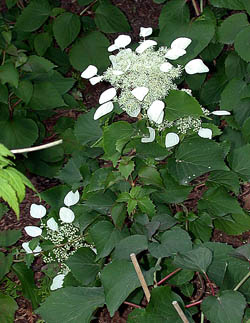 Schizophragma hydrangeoides - flowers (photo Sz. Marczynski) Schizophragma hydrangeoides - flowers (photo Sz. Marczynski) | 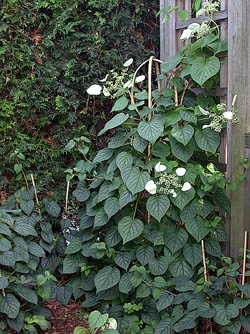 Schizophragma hydrangeoides 'Moonlight' (photo Sz. Marczynski) Schizophragma hydrangeoides 'Moonlight' (photo Sz. Marczynski) |
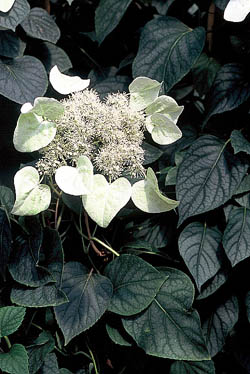 Schizophragma hydrangeoides 'Moonlight' - flowers - photo Sz. Marczynski Schizophragma hydrangeoides 'Moonlight' - flowers - photo Sz. Marczynski | 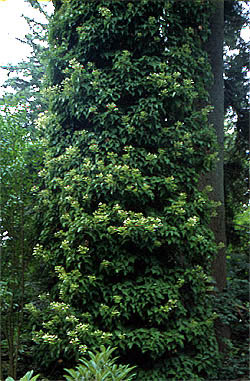 Schizophragma hydrangeoides climbing up the tree - photo Sz. Marczynski Schizophragma hydrangeoides climbing up the tree - photo Sz. Marczynski |













